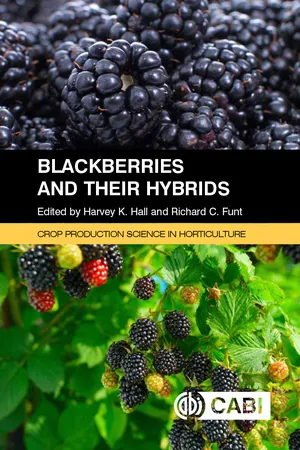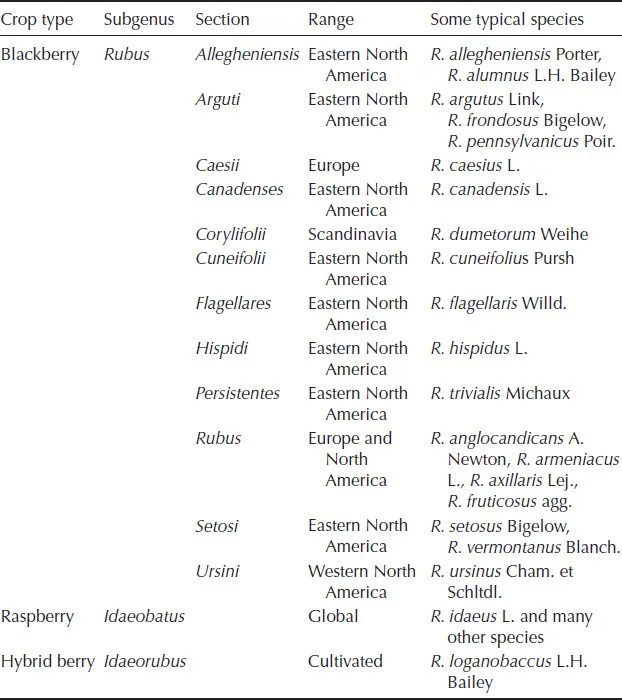![]()
1
BLACKBERRIES: AN INTRODUCTION
Kim E. Hummer*
U.S. Department of Agriculture, Agricultural Research Service, National Clonal Germplasm Repository, Corvallis, Oregon, USA
What was known as a favorite seasonal specialty fruit crop for many in the northern hemisphere can now be purchased in grocery stores throughout the year. What was historically gathered from the wild in Europe and North America has expanded into commercial cultivation and is now available globally.
Enhanced germplasm is providing a wealth of traits to create new growth and production opportunities. New cultivars have been developed with unusual qualities and great changes in crop production have occurred recently. In addition, production regions have expanded internationally in areas where innovative methods must be used to produce a crop for commercial production.
CLASSIFICATION AND DISTRIBUTION
Blackberries are members of Rubus subgenus Rubus (previously called subgenus Eubatus), while raspberries, their close relatives, are grouped in Rubus subgenus Idaeobatus. From a horticultural standpoint, each blackberry fruit is an aggregation of drupelets. Each drupelet is derived from one ovary that produces one hard-coated seed (pyrene). The seed is incased in a fleshy mesocarp with a surrounding exocarp (fruit skin). The drupelets are attached to a receptacle (torus). When the fruit is ripe, the drupelets remain attached to the receptacle, breaking away (dehiscing) from the stem (petiole) as a single unit ready for consumption. In contrast, the drupelets of raspberries separate from the receptacle. Raspberry drupelets are held together by small hairs and form a hollow, edible ‘cap.’
This horticultural distinction of the fruit of blackberries and raspberries, while being an easily determined visual characteristic, is botanically arbitrary. This is because of the nature of species and cultivars within the genus, and the great propensity of divergent groups to outcross, even those that differ in the number of chromosome sets. Many fruits that have a blackberry type fruit may contain raspberry genes in their evolutionary history, e.g. the western dewberry, R. ursinus (Alice and Campbell, 1999).
Blackberry plants grow in the temperate zone and have many forms. Most blackberries are ‘armed.’ That means that they have ‘thorns,’ or what botanists term ‘prickles.’ Besides having thorns or prickles on their stems and petioles, blackberries may also have bristles. Frequently, thorny blackberries also have thorns on the mid-rib on the underside of the leaves.
Blackberry plants can grow as trailing or upright plants or something in between. The trailing form, called ‘sarmentous’ by botanists, grows prostrate to the ground, similar to a grapevine. The prickles on the stem allow the blackberry vine to climb on other tree and shrub species and grow on top of them. In this case the vines are referred to as ‘lians.’
For the other extreme, some blackberries have stout, thick stems and can grow upright to as much as twice a person’s height, particularly in the first year of growth. This type of cane is called the primocane. Some blackberry plants have a growth habit in between prostrate and upright.
Since the time of the ancient Greeks, thornless blackberries were observed and described (Hummer, 2010; Hummer and Janick, 2007). Blackberries were cultivated in Europe for over 2000 years, initially for providing a protective barrier around areas of human habitation, then for medical purposes and for consumption. The first cultivated blackberry mentioned by name in European literature was the cut-leaf blackberry R. laciniatus, in Plukenet’s Phytographia in 1691 (Jennings, 1988). This species was introduced into the Pacific Northwest of the USA and Canada before 1860 (Jennings, 1988).
The crowns of blackberries are perennial. In many blackberries the stems or canes that grow out of the crown are biennial: they grow one year, and die the second year. The first-year cane is called a primocane. In late summer, flower buds are initiated in a terminal raceme. A raceme has two qualities: (i) it is an arrangement of flowers on a stem where the youngest flower bud is at the tip; and (ii) the new flowers can keep growing out in an ‘indeterminate’ growth pattern. These primocanes and their buds overwinter. The buds receive chilling (between 4 and 6 weeks of temperatures near freezing) and break in the spring when the temperatures warm. The second-year cane is termed a ‘floricane.’ The flower buds on the floricane bloom and develop into fruit. The floricane dies at the end of the summer, after the blackberry fruits are harvested.
HOW MANY BLACKBERRY SPECIES ARE THERE?
More than 700 Rubus species have been described (Lu and Boufford, 2003). Focke prepared the first global monograph of Rubus (1910, 1911, 1914; see also 1894). He suggested 12 subgenera. Watson (1958) modified the subgenera and placed the blackberries into Rubus subgenus Rubus. This subgenus contains 12 sections (Table 1.1) of which species from most have been used in breeding programs to improve the cultivation of wild blackberry fruit.
The subgenus Idaeorubus describes a specific hybrid species: the presumptive hybrid R. loganobaccus L. H. Bailey, which was likely R. idaeus × R. ursinus. This subgenus represents one type of hybrid blackberry but by no means encompasses the diversity of raspberries Rubus subgen. Idaeobatus crossed with blackberry species Rubus subgen. Rubus.
Table 1.1. Subgenera, sections, and species of blackberries, raspberries, and hybrid berries.
WHERE ARE BLACKBERRIES FOUND?
Rubus species occur on every continent except Antarctica, and are most diverse in the northern hemisphere. Many species occur in Europe and North and South America but only a few are found in Africa, Australia, and Oceana. Considerable phenotypic variation is found among the European blackberry species. Jennings (1988) refers to nearly 5000 Latin names having been recorded. He refers to these names as the tendency to recognize ‘microspecies.’
HOW DOES THE LATIN NAME OF BLACKBERRY SPECIES AFFECT INTERNATIONAL TRADE?
Many people want to cultivate plants from different regions throughout the world. While this is great for new business, the challenge is to import clean plants, excluding novel diseases from the new production area. Quarantine regulations have been enacted by regional governments to insure that plants can move safely across country or regional borders without spreading diseases, Biosecurity regulations severely restrict or prohibit movement into some countries, especially Australia due to the ‘weediness potential’ of some species and some commercial cultivars. Plant pathologists report the diseases that have been observed in specific localities. Quarantine regulations are based on those reports. The report of a plant diseases includes the:
1. Latin name, usually genus species, of the plant affected by the disease, and
2. Locality where the disease occurs.
Plant health permits, such as plant import permits or phytosanitary certifications, are defined by quarantine regulations, and are written with those two particulars in mind. Thus, if a nursery wants to produce and ship plants across a border to another country or region, the plant species and origin must be known and specified. Plants grown in an area where diseases occur, or to be shipped to a country where certain diseases are absent, must be tested for or certified against the particular disease agents to be allowed entry.
The definition of species names for blackberries are problematic. Particularly, recent cultivars for this crop have complex pedigrees that include multiple blackberry species. Different cultivars have differing percentages of these species in their background. The botanists haven’t kept up with the blackberry breeders and geneticists in describing new binomials for all possible blackberry species hybrid combinations. Because the backgrounds and pedigrees of new blackberry cultivars must be described in detail for intellectual property right protection, inventors have been creative with their reference species designation for the blackberry. A review (Table 1.2) of the USA Plant Patent database for blackberries shows that over the past 38 years, breeders have used differing binomials when referring to new blackberry cultivars, including:
Table 1.2. USA Plant Patent database for blackberries.
Rubus allegheniensis
Rubus canadensis
Rubus hybrid
Rubus spp.
Rubus fruticosis aggr.
Rubus trivialis
Rubus ursinus
Breeders in other countries have also used these binomials. The Latin binomials are appropriate for sport mutations or selections directly from the wild species but not for multiple species pedigrees. The name R. hybrid, is indistinct, and could be applied to any species cross within the genus, not necessarily to only blackberries species. The R. spp. or R. sp. choice implies that unknown species within the genus were the parents, and would not necessarily imply that the subject cultivar is a blackberry. The fourth, R. fruticosis, is a name invented by Linnaeus, and now refers to a group or aggregate of European blackberry species. Several countries, such as Australia and the United States, have specific noxious weed restrictions against ‘R. fruticosus,’ so that reference may bring additional undesired constraints on a cultivar named in that category.
Recently another approach has been used for designating the complex taxonomy of blackberry cultivars. As previously mentioned (Table 1.1), blackberry species from Europe, Scandinavia, and eastern and western North America are included in Rubus subgenus Rubus. Breeders who have used a complex combination of those blackberry species have begun using this naming convention. Plant pathologists who are reporting diseases for blackberries are also using that convention.
The hybrid berries are an increasingly greater portion of the economically important blackberry type of fruit production. Breeders will continue to use available genetic flexibility to draw on the genes from both blackberries and raspberries to produce new cultivars adapted to broadening climate niches.
In this volume, reports on developments in the blackberry industry have been described by international experts in 17 chapters. This book provides a comprehensive yet concise reference for horticulture students, blackberry growers, producers, and fruit industry personnel looking for the latest production information. A summary of each section of the book follows...








